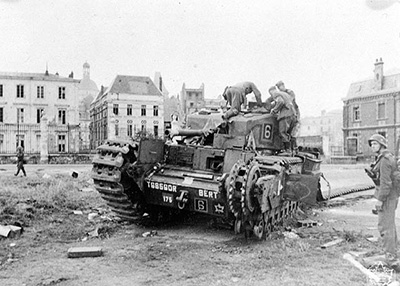
WWII: Maginot Line | Normandy | V-Weapon Sites | Arnhem
Further afield: Crete
| Home Tracing Military Ancestors Travel Advice CWGC Cemeteries Iron Harvest News Book Reviews Glossary Links Contact Me Normandy Landings:
 
|
The D-Day Beaches of Normandy – A Brief HistoryStrategic BackgroundThe Allied invasion of Normandy which began on 6th June 1944, was, quite simply, the greatest combined military and naval operation in world history. Launched in the fifth year of the Second World War, its aim was to re-establish British, Canadian and American forces on the mainland of Europe. Once there it was envisaged they would bring the German army in the West to battle, defeat them and seek the unconditional surrender of all German forces in Europe. After her ejection from Dunkirk in June 1940, Great Britain had been unable to engage the German army on the European mainland. Indeed her forces were not strong enough to contemplate anything more than operations on the European periphery in North Africa and the Mediterranean, where her naval strength compensated somewhat for her weakness on land. Even when Germany invaded the Soviet Union in June 1941, Hitler still had enough divisions in the West to make any re-invasion of Europe by the British hazardous, if not suicidal. The figures speak for themselves. At the end of 1942 Britain possessed just 13 fully equipped divisions that were available for a cross-channel assault, whilst Hitler, despite despatching no less than 190 divisions against the Soviet Union, could still find 27 divisions to defend France. When the United States entered the war against Germany in December 1941, they spent much of the following year raising and training recruits to swell their small and inexperienced army. Only in November 1942, were they able to take the field in North Africa and even then, they fought very much as junior partners to the British and Commonwealth forces. Throughout 1942 Stalin placed constant pressure on the Allies to open a “Second Front” against the Axis powers in Europe but Prime Minister Winston Churchill was wary. As the chief architect of the infamous Gallipoli debacle during the First World War, he was acutely aware of the difficulties involved in landing and supplying a large army on an enemy shore. His fears appeared to be confirmed when, stung by Stalin’s criticism of Allied inaction and buoyed by the successful commando raid on St Nazaire, a direct attack was made on the French port of Dieppe. Operation Jubilee, launched on 19th August 1942, was a costly failure. The objective had been to capture the port and town, destroy some coastal guns and then retire in good order. But many of the attackers never got off the beaches. Alerted to the impending landing by a patrol boat, the German defenders, firing from well-fortified positions, annihilated their attackers. By the end of the day the Anglo-Canadian assault force had suffered 3,371 casualties. Terrible though this carnage was, it taught the British two valuable lessons – the importance of landing specialised armour with the infantry to deal with beach defences and that frontal attacks on heavily fortified harbours should be avoided at all costs.
As 1943 dawned, however, events on the ground began to turn in favour of the Allies. In North Africa, Rommel’s Afrika Korps was defeated by General Montgomery at El Alamein, and the Torch landings in Algeria and Morocco forced the Germans to retreat into Tunisia. Meanwhile, in the east, the German Sixth Army was surrounded and forced to surrender at Stalingrad in what was the Second World War’s key turning point. Against this backdrop, at the Casablanca Conference in January 1943, Churchill and Roosevelt appointed the British General F.E. Morgan to the post of Chief of Staff to the Supreme Allied Commander (COSSAC). He was given the joint tasks of planning for a cross-channel invasion in early 1944 and creating a deception plan to keep the Germans guessing as to where a landing would take place. |
